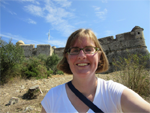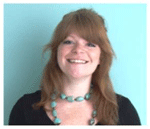It’s ESOMAR’s 67th annual Congress, this year held in Nice, France. This year we look at “what inspires” and our event team have been working hard to provide the industry with some of the best and most inspiring content within and outside the industry. To cover the event and ensure those that couldn’t make it could get the feel of the conference, we sent our intrepid reporters Annie Pettit and Anna Peters to give their view of one of the biggest research conferences in the industry calendar. Here are their highlights of the 1st day.
Choose Your Attitude
I will admit it takes a lot to impress me. I go to many conferences around the world and listen to many people share incredible stories. But this morning’s keynote by Debra Searle literally, not figuratively, brought a few tears to my eyes. Debra competed in a rowboat race across the Atlantic Ocean. 3300 miles over 3.5 months. By herself.
Rowing has nothing to do with marketing research, but Debra wove a passionate story of optimism in the face of sure failure that made everyone in the room think twice about their own careers. She spoke about her irrational fear of sharks ripping apart her tiny boat and a very real fear of container ships plowing right through her. She spoke of rowing furiously to get ahead while a sea turtle casually kept pace with her, and storms that pushed her 10 kilometers back of where she had started the day. She spoke of the racing authorities being certain they’d need to rescue her because other rowing teams with two big, strong men had already pulled out.
But Debra also spoke of being inspired by thousands of fans around the world sending heartwarming text messages. She spoke of her team back on land at home that was so dedicated to her success that they met her mid-ocean with a basket of Christmas decorations (this is where I had to hold back a few tears). And most importantly, she spoke of visualising the glorious end of the race where she would put her arms around her husband, stare her mom in the face, and be proud of her amazing dedication and accomplishment.
Debra left us with two key messages. You must go to the ends of the earth for your clients – bring them that basket of optimism no matter if it feels like you have to cross the ocean to get it to them. And secondly, you must choose your attitude – choose to see the end of the race not quitting the race, choose to see success for yourself, choose to see the positive in everything even when so much seems to be screaming you are going to fail.
I also absolutely loved the talk by Tobias Wacker of BrainJuicer and Vanessa Oshima of Coca-Cola. If you had never conducted any research yourself but only attended conferences, you would think that researchers have a 100% success rate. We talk of wins and successes and great new innovations but Tobias and Vanessa shared a story of failure. And the audience was riveted. After their research project was completed, Tobias and Vanessa realised that they didn’t understand the research objective, they didn’t have clarity on the audience for the results, they didn’t have realistic timelines, and they didn’t raise the failure flag soon enough. To recognise these failings and then fix them in a subsequent project is really impressive. And to have the courage to share them in front of 500 people? Well, that’s more courage than I have.
The last presentation I’ll mention was by Giuseppe Tonolini of The Marketing Lab and Simona Sbarbaro of the Luxottica Group. In recent years, there’s been a lot of chatter about Millennials. Researchers have done hundreds of studies, written many books, and tried desperately to figure out this group of people who think about me rather than we, who take selfies, who text more than they email, and who think of their mom and dad as friends rather than parents. It makes me wonder though. Is it really millennials we care about, or rather the next generation of youth? You see, every generation of youth is vastly different than the generation before. If you go back far enough, one generation of youth had access to an astonishing invention called ‘fire’ that the generation before did not. Perhaps we ought to be thinking about cultural cohorts, not age. Or as David Bunker (BBC), Kevin Cowan (BBC) and Lisa Edgar (The Big Window Consulting) put it, perceived age.
If you want something different, then do something different: Don’t talk to consumers
“The research industry is at a crossroads” – Dan Foreman
“Our industry is at a time where we need to think differently” – Dider Truchot
Inspiration, stimuli that make people want to do or create something different, is put forward by ESOMAR congress as the solution to the cross-roads. Because, if the industry wants something different, then it must do something different.
But what is different?
For Dider Truchot, founder of IPSOS, difference comes from frustration with the status quo.
For Debra Searle, the woman who has done so much more than row single-handedly across the Atlantic, difference comes from choosing the right attitude.
For Vanessa Oshima, VP at The Coca Cola Company, difference comes from not being boring.
For Market Research, doing something different means taking the cornerstones of what we do, and not doing it. This means research without questions and insights without interviews.
Day 1 of ESOMAR was kicked-off with a session on the ‘art and science of research without questions’ where it was predicted that in the next 5-10 years silence will be an important addition to the Researcher’s toolkit. In the context of Market Research, silence involves looking at our clients products in the context of consumers own personal lives – without having to rely on self-reported data or without having the to rely on the eyes and ears of a researcher. It is, of course, technology which will enable this to happen and Comedy Central and The Coca-Cola Company are two big brands which have been researching without questions – and still getting big answers.
Comedy Central, in conjunction with GfK, used EMO Scan technology to avoid questions. They measured laughter and the positive affect that it has on everything from sex life, though to consumer receptivity to advertisements. EMO Scan technology uses home-based facial recognition software to measure facial reactions in real-time; something which simply isn’t possible using traditional methodologies – in part because it is difficult to articulate and self-report on something which is so emotional.
Similarly, The Coca-Cola Company worked with BrainJuicer to avoid asking their consumers any questions. Instead of speaking directly with consumers they used DIGIVIDUAL technology to aggregate consumers’ online conversations. By using bots they were able to make sense of existing big data, but more importantly they were able to sort and segment this sea of information in a useful way: they could identify where their product sat in the context of their customers whole [online] lives. Off the back of this work they were able to make changes to their Japanese canned coffee brand, and help consumption of their black coffee product rise by +50%.
Of course, difference in market research isn’t just reliant upon new technologies – and the difference that existing techniques, such Neuroscience, Gaming and Semiotics, deliver were all discussed on day 1. What unites all of these techniques is that they all avoid the traditional question and answer format which is so often associated with Research. So, it seems that ‘doing something different’ in the context of Market Research may well lie in not talking to consumers: a new size, scale and texture of insights is required which makes the face-to-face question and answer format seem a little outdated.
To sum-up, difference is my theme of day 1 at ESOMAR 2014 – and all speakers delivered on this. But difference is something which conference sponsors did fail to deliver on: sponsors were invited to take to the stage for 60 seconds in order to ‘pitch’ to the audience. This was their opportunity to seem different. But every pitch was delivered by a middle-aged man, in a grey suit, clicking though power-point slides.
Which doesn’t seem terribly different from where I’m sitting.
Annie Pettit is Vice President of Research Standards, Research Now
Anna Peters is a freelance researcher based in London




